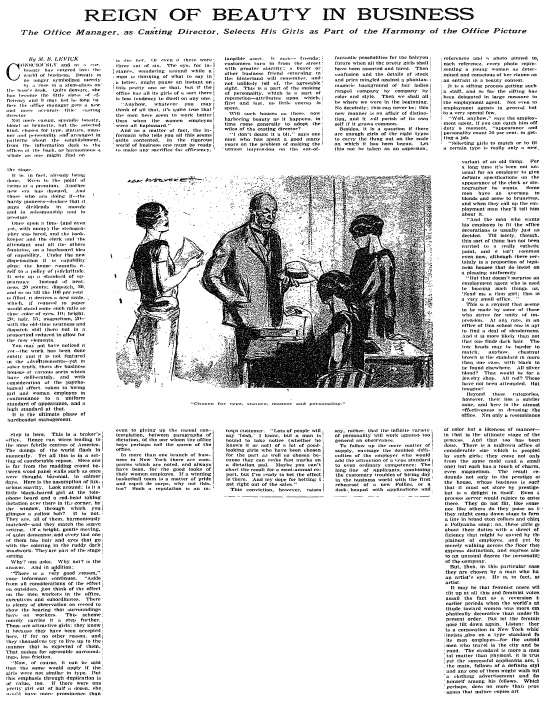
In a June 1924 New York Times Magazine article, M.B. Levick analyzed the rise of women’s looks as a preeminent qualification in hiring.
The era of “first wave feminism” is considered to have lasted from 1848, with the first Women’s Rights Convention, to around 1920, when women were granted the constitutional right to vote. Well, it had clearly ended by 1924.
Once upon a time… the stenographer was hired, and the bookkeeper and the clerk and the attendant, and all the others feminine, on a haphazard idea of capability. Under the new dispensation it is capability plus: the house commits itself to a policy of pulchritude [beauty].
It sets up a standard of appearance. Instead of “neatness, 20 points; dispatch, 30,” and so on till the 100 percent is filled, it derives a new scale — which, if reduced to paper would stand some such ratio as this: “color of eyes, 10; height, 20; hair, 15; magnetism, 20” — with the old-time neatness and dispatch still there, but in a proportion reduced to allow for the new elements.
Levick even ended with a paragraph warning feminists not to worry about it:
It may be that feminist noses will tilt up at all this and feminist voices assail the fact as a reversion to earlier periods, when the world’s attitude toward women was more emphatically decorative than under the present order. But let the feminist nose tilt down again.
After all, Levick reasoned, men often must meet a certain standard for hiring too — though acknowledging that “the standard is more a mental matter than physical.” (So in other words, the comparison was completely inapt.)
Listen: there is a corporation in New York which insists also on a type standard for its men employes [sic] — for the outside men who travel in the city and beyond. The standard is more a mental matter than physical, it is true, yet the successful applicants are, in the main, fellows of a definite style and any one of them might walk into a clothing advertisement and feel himself among his fellows.
Which begs the question: was the writer M.B. Levick male or female? Surprisingly, I’m finding that question shockingly difficult to ascertain online.
There was no short “about the author” bio, the way New York Times Magazine (and almost every journalism publication) includes nowadays. And while googling Levick’s name produces some results, such as their archive of New Yorker articles, nothing about their sex.
That final paragraph of theirs does seem extremely “male,” though.
Reign of Beauty in Business
Published: Sunday, June 15, 1924
Leave a comment